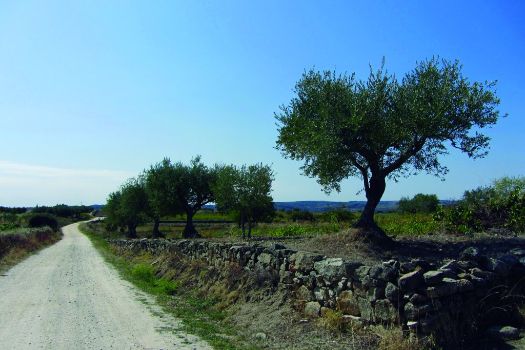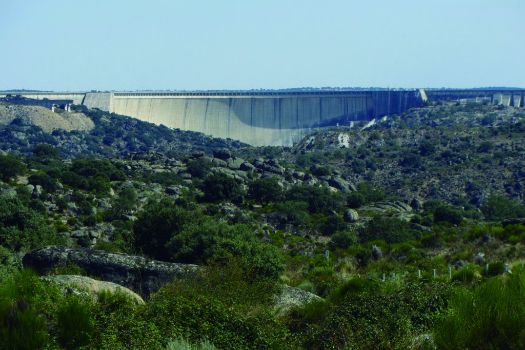Net of Natural
Trails

Stage 32: Fermoselle - Trabanca
Description
On the banks of River Tormes: Between Zamora and Salamanca
Vineyards and olive groves escort the road from Fermoselle to Trabanca; and the River Tormes, forcefully held back by the huge La Almendra Dam, silently witnesses the march of hikers.
The route begins at Fermoselle. It heads down General Mola Street and crosses the intersection with CL-525. It then continues along San Juan Street and Eras Street, until it crosses the CL-525 again near a small square. Soon after, the route leaves the streets behind and reaches an intersection where it turns right. After about 250 metres, it crosses the CL-525 again for the last time.

The route definitely leaves Fermoselle behind along a well-paved, wide path near a few farmsteads with olive groves and vineyards at a place known as Paraje del Álamo Blanco. Throughout most of the Stage, the route will continue along this path, flanked by farmsteads. This is a good example of how the peneplain resources of Arribes del Duero are used to grow olive trees, vineyards, almond trees, etc.
At the fork, the path takes the left branch along Camino de la Aceña de la Cicutina, ignoring the Camino de la Carrera de los Olivos. An "aceña" is a water-driven flourmill in the middle of the river, and the Cicutina is a site near the River Tormes to which the path leads.
At one point, the wide farm access road disappears, and the route continues along a narrow path that leads down to the River Tormes.
The climb down is easy, amidst holm oaks (Quercus ilex) and yellow brooms (Retama sphaerocarpa), as well as junipers (Juniperus communis), terebinth or turpentine trees (Pistacia terebinthus) butcher's-broom (Ruscus aculeatus) and other small shrubs. One can admire from here the summit of Mount Picón, of outstanding beauty with its typical cone-shaped peak (657 m).

Once in the bottom, the path head upstream parallel to the River Tormes, until it reaches San Lorenzo Bridge. This walk alongside the river is very pleasant. One can see the large variety of plant species that form a dense gallery forest.
Before the bridge, the route joins the ZA-316 (later, SA-316), and continues for a few kilometres along the road until it turns onto a path that emerges on the left, now in the province of Salamanca.
The path climbs up towards Picón de la Paya. Shortly after, it reaches Somaero Viewpoint, with excellent views over the Tormes Valley. Somaero Fountain, Falla del Peine Refuge and the "chiviteros" of Somaero are located further ahead.
Before reaching Trabanca, one can enjoy spectacular views of La Almendra Reservoir, which holds the water from the River Tormes.
The climb is now over. Here, the path widens and is better surfaced. From here, the route continues through rolling hills, with small farms on either side of the road, until it reaches the town of Trabanca, the endpoint of this Stage.
Sites of interest
Profile

Highlights
Further information
The olive tree and its oil in Arribes del Duero
Olive groves have existed in Arribes for more than six hundred years, covering much of the county.
They were an essential part of the area's economy, where olive oil was used for local consumption and for trading with the other towns in the area and across Castile.
This trade contributed to the sustained growth of olive farms, while greater specialisation was needed in modern times. Thus, in mid-20th century, vineyards were interspersed amidst the olive groves in the north, and fruit trees in the south. In some villages, they even colonised terraces and hunting reserves.
However, despite the income earned from its trade, this labour-intensive crop was significantly affected by population loss through emigration. Like the rest of the crops grown on terraces, they were abandoned or neglected due to labour shortage and the physical impossibility of using machinery.
Nowadays, agricultural subsidies and renewed interest in the county and its products have led to better management and recovery of the crop.
On the banks of the river
Peneplain rivers, such as the Tormes when it flows through this area, play host to a large variety of wildlife. The slow water and width of the river appeal to many species that choose to live here.
The River Tormes is home to different fish species, including catfish (Barbus sp.), chub (Squalius sp.) or Northern straight-mouth nase (Pseudochondrostoma duriense); birds, such as Grey Herons (Ardea cinerea) and Kingfishers (Alcedo atthis); and mammals, including otters (Lutra lutra) or American mink (Mustela vison).
The vegetation is lush and diverse, which favours the presence of herbivores like the Southwestern water vole (Arvicola sapidus). Alders (Alnus glutinosa), willows (Salix sp.), elms (Ulmus sp.) and poplars (Populus sp.) are the dominant riparian tree species. Eurasian Golden Oriole (Oriolus oriolus), warblers (Sylvia sp. and Acrocephalus sp.) hide, and even nest within, as is the case of the Penduline Tit (Remiz pendulinus) with its sock-shaped nest.
Underwater, small invertebrates and crayfish feed on small insects and submerged plants.
The multi-coloured European Bee-eaters (Merops apiaster), Barn Swallows (Hirundo rustica) and Bank Swallows (Riparia riparia) breed in the earth embankments, which they abandon to winter elsewhere or find a better nest.
La Almendra Reservoir
In the northwest of Salamanca, the River Tormes is held back by a formidable hurdle, La Almendra Reservoir, before emptying into the River Duero. The reservoir is a genuine inland sea covering nearly 8,000 hectares of flooded land. Its uniqueness lies in that the slipway of the power plant is 15 kilometres away at Villarino de los Aires, to where the water is channelled through a tunnel seven metres in diameter carved into the rock.
La Almendra Reservoir is one of the largest in Europe and the third largest in Spain. It is an artificial lake where one can practice different water sports, fish or even bathe in its crystal clear and extremely deep waters.




